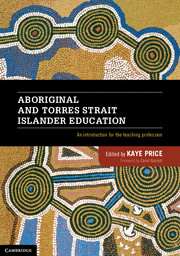Book contents
- Frontmatter
- Contents
- Contributors
- Acknowledgements
- Chapter 1 A brief history of Aboriginal and Torres Strait Islander education in Australia
- Chapter 2 The Stolen Generations
- Chapter 3 Delivering the promise
- Chapter 4 Your professional experience and becoming professional about working with Aboriginal and Torres Strait Islander students and communities
- Chapter 5 The ‘silent apartheid’ as the practioner’s blindspot
- Chapter 6 Better
- Chapter 7 Maths as storytelling
- Chapter 8 Information and communication technologies in the classroom
- Chapter 9 Language and literacy
- Chapter 10 Aboriginal and Torres Strait Islander Studies in the classroom
- Chapter 11 Engaging Indigenous students
- Appendix A Take a book: Any book
- Appendix B1 Terminology
- Index
- References
Chapter 4 - Your professional experience and becoming professional about working with Aboriginal and Torres Strait Islander students and communities
- Frontmatter
- Contents
- Contributors
- Acknowledgements
- Chapter 1 A brief history of Aboriginal and Torres Strait Islander education in Australia
- Chapter 2 The Stolen Generations
- Chapter 3 Delivering the promise
- Chapter 4 Your professional experience and becoming professional about working with Aboriginal and Torres Strait Islander students and communities
- Chapter 5 The ‘silent apartheid’ as the practioner’s blindspot
- Chapter 6 Better
- Chapter 7 Maths as storytelling
- Chapter 8 Information and communication technologies in the classroom
- Chapter 9 Language and literacy
- Chapter 10 Aboriginal and Torres Strait Islander Studies in the classroom
- Chapter 11 Engaging Indigenous students
- Appendix A Take a book: Any book
- Appendix B1 Terminology
- Index
- References
Summary
To preface this chapter, and the lens applied to it, a return to earlier experiences of ‘becoming’ is appropriate – becoming a state-school student, becoming a state-school teacher. Upon reflection, I had, as a child, become a sound state-school student within a culturally diverse student group. The physical environment, from infants and primary school sites to the secondary school site, was not particularly diverse. It was often characterised by interiors of neutral-coloured linoleum, regulation departmental mid-blue accents, modular timber cupboards and exteriors defined by seriously brown brick walls, asphalt playgrounds and modestly allocated grass areas. Grey wire fences surrounded the built environments of almost every school site. Landscaping was limited to an agglomeration of concrete-bound, sandstone forms providing an edging to the asphalt usually located near the entrance of the school. The plants inside them were mostly hardy ‘natives’ which, irrespective of their apparent ‘suitability’, seemed to struggle to survive.
At that early age, I was becoming aware, accurately or not, that this was (normal) schooling.
After leaving school, becoming a teacher became an important phase of my life. What did it mean to become a teacher? Did it mean satisfactorily completing requirements proposed by lecturers and administrators as a part of a degree? That was a part of professional certification, but it was upon entry into the profession that I became aware of the full array of expectations, responsibilities and opportunities that are part of becoming a teacher. It was also where I came to understand some of the inequities and gaps that existed for Aboriginal and Torres Strait Islander students within education systems and settings, which gave me cause to reflect again upon my own education.
- Type
- Chapter
- Information
- Aboriginal and Torres Strait Islander EducationAn Introduction for the Teaching Profession, pp. 52 - 63Publisher: Cambridge University PressPrint publication year: 2012
References
- 3
- Cited by



